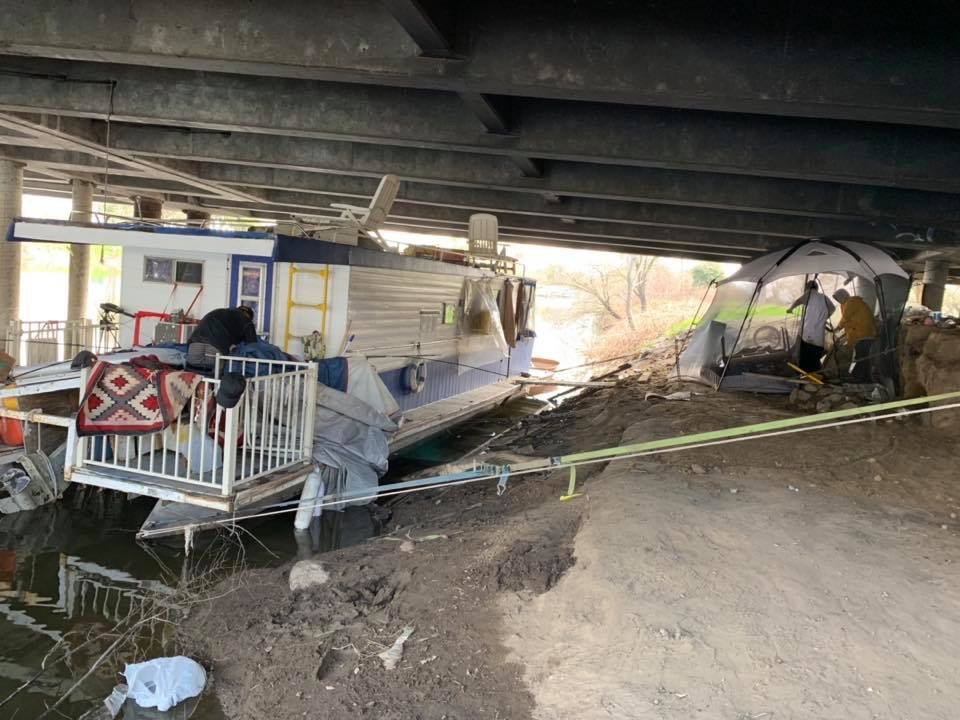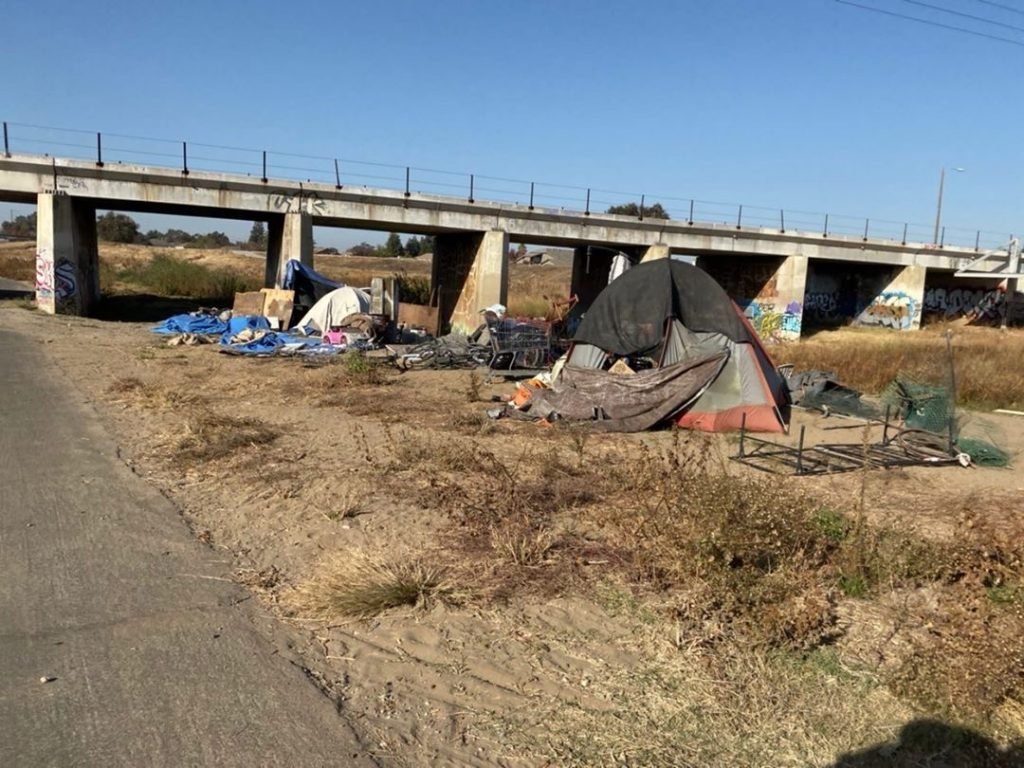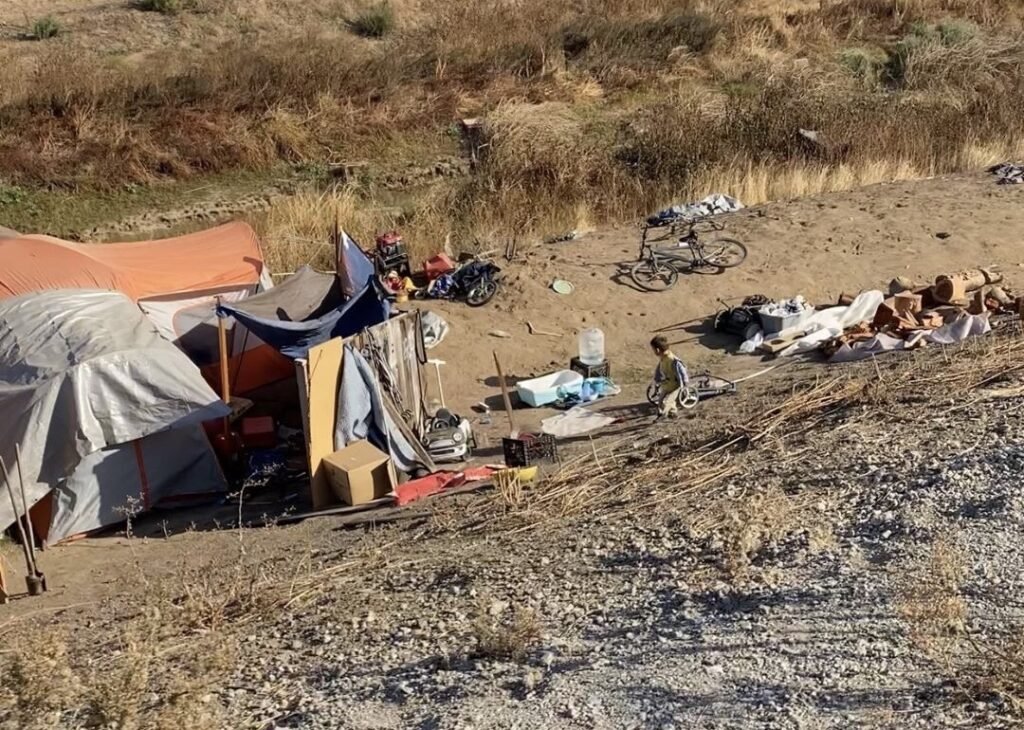
By Patrick Eley
Californian public opinion is caught between a rock and a hard place. 93% of San Joaquin’s residents believe homelessness is a worsening problem that we must address. They also believe the steps taken so far are inadequate. The voters aren’t wrong and for the last year opposing views of county officials have placed actions to address the greatest humanitarian need of our generation at a standstill.
Nine years ago, the Obama administration had the nation enthusiastic about tackling homelessness, spearheaded by what many call a Housing First Model. The then-president proclaimed that in ten years homelessness would be a thing of the past. Now, as we close in on a decade, the progress is nonexistent. Homelessness is worse than ever, and the bureaucrats at the helm of many of the agencies assigned with building homeless shelters and community aid have gotten richer. The dollars don’t make sense.
Housing First Model
Complicated accounting and multi-layered initiatives have masked disingenuous efforts in California, but now the physical disturbance of the growing homeless population can no longer be explained away. Let’s take Los Angeles. The city spent billions of dollars building housing for the homeless. Housing meant to be a temporary solution for the disenfranchised to use a springboard to becoming self-sufficient has had an average cost of $750,000 per 1 room apartment ($450,000 in San Joaquin), more than a single-family home for people who work and pay taxes. No amount of woodwork or cabinetry justifies the cost. It simply lined the pockets of layers of “agencies.”
The true beneficiaries of these programs are nonprofits and state agencies. Some of these issues point to a larger problem of the ballooning industry that public welfare has become. The homeless efforts morphed into the homeless industrial complex.
We are at a tipping point. This year a federal judge in Los Angeles froze a billion dollars in funding. He placed it in a trust and mandated that the homeless be placed in shelters, regardless of their compliance issues, by the fall or the funding would stop. New York had proven that highly populated cities could use money efficiently to shelter those in need by using components of enforcement and sheltering levels to rehabilitate those eligible while removing the dangerous elements brought to the city by leaving homeless on the streets unpoliced.
Nonprofits Profiting
Nonprofits maintain an ever more suspect classification within America’s business divisions. So many visualize nonprofits as barebones do-gooders operating on a shoestring budget. Still, nonprofits have been very successful business models for the profit of their employees over the last three decades. Nonprofits are obligated to pay employees within a realistic salary range, meaning you can’t pay someone a million dollars a year to work 3 hours a week. Still, with bonuses, retirement, and healthcare incentives, nonprofit executives can make top-tier salaries.
Nonprofits aren’t supposed to have profits on paper. Profits are expected to be put back into the nonprofit’s cause each year. To manipulate that policy, money often goes into programs that benefit the employees in the form of work trips, office amenities, and unnecessarily long programs that guarantee employees more job security even if a project could be finished more quickly.
The nonprofits within the homeless industrial complex don’t have much incentive under the current model to fix homelessness. They would be out of a job. Because they hide profits by lining organization pockets, much of the free market competition to do the best job on a project is eliminated once one becomes entrenched in the flow of funding. When placed under local scrutiny, California agencies and nonprofits addressing homelessness point to the federal government, claiming, “Hey, this is what the government wants. Our job is to keep building more and more under their regulation.”
They refrain from demanding that more efficient models be used and make sure they allocate any funding they receive as quickly as possible. Policymakers at the ground floor have at times pretended there aren’t other approaches. They also fudge the numbers.

Housing First Never Meant Just Housing
The Housing First model was never meant to just build housing complexes from scratch as a fix to the homeless. It was a comprehensive idea introduced in the 1990s after years of data collection. Housing First meant that homeless people should get a safe place to sleep before being pushed to rehabilitate themselves into society. Research demonstrated that people better address their problems when basic needs, such as food and a place to live, are met.
Greed has bastardized the well-intentioned philosophy. Many organizations created housing but then demanded that the homeless receive treatment, meet job search requirements, or accept skills training on a timeline proven to fail and return more than 90% of the unsheltered to the street. All the while, these nonprofits continue to cash in on federal and state funding.
With homelessness spiraling out of control during the pandemic, in large part because of these rigged programs, Congress included wording in the CARES Act that barred any of the $4 billion in pandemic homeless aid from being used “to require people experiencing homelessness to receive treatment or perform any other prerequisite activities as a condition for receiving shelter, housing, or other services.” They did this to stop the corruption, but it’s been hard for the federal government to keep track of their dispersed money on a local level.
All American data supports two facts. First, society is safer if the homeless are sheltered, regardless of their compliance. Second, the homeless need access to sobriety and job training programs to have a probability of rehabilitation. Here lies the disconnect between the philosophy and the implementation of Housing First.
The San Joaquin County government is at a pivotal juncture, where action to address the greatest crisis of our time is paramount. They have the opportunity to implement support for the homeless correctly but not without coming together first. The county needs to reform its approach. Instead of repeating the failed Housing First model, policymakers need to take a different first step. The community is at once in a generation intersection with sufficient data, funding, and representation to solve this problem if the ever-present bureaucratic greed can be overcome.
Part of that task is illuminating the issue to the people of California in language they can understand, instead of the typical barrage of legalese, bill numbers, and committee names that are traditionally used to influence a voting population. In this article, we are going to examine homelessness from a sociological perspective before looking at programs from around the country that have worked, along with why programs in California fail. The county and the cities of the 13th district wisely want to implement evidence-based programs that show proof of concept before releasing excessive amounts of funding. They want to ensure synergy between the agency and nonprofit beneficiaries. Stockton’s citizens need to be informed so they can demand accountability from those in power sabotaging the situation.
A Roof Over Everyone’s Head
We can create structures where the unsheltered have a warm place to sleep behind a locked door and reliably keep possessions without fear of theft. Our communities can supply adequate nutrient-dense calories to maintain healthy body weight and clean showering facilities to remain groomed. We can provide the unsheltered with a degree of shelter that allows them to present themselves professionally and restore some dignity to their lives.
For the homeless to change their condition, they must work and grow, not just receive services. The biggest change many must make is overcoming addiction. The worldwide data clearly shows that no one is rehabilitated if sobriety isn’t required at some point in homeless programs. The data also indicates that forcing sober compliance on day one of entering shelter only results in delinquency, so the answer lies in a progressive agenda that works on realistic timelines for adults to change. Like most things in life, navigating the road to success means embracing nuance.
A Boise, Idaho decision in the 9th circuit court ruled that you need to offer an alternate location and a bed to enforce any restriction on camping effort. We need to put the beds in place now– not in three to five years like those trying to profit have pushed. A year ago, Stockton had preexisting structures ready to receive with a few months of remodeling; however, certain county supervisors held up action and the real estate is now off the market.
We currently have the opportunity to build a 300-person capacity Sprung structure like ones currently being used successfully in San Diego. Sprung structures use fabric membranes from aerospace development that offer amazing all-weather durability and strength cost-effectively. They can be erected much more quickly than traditional structures and are used around the world as field hospitals, schools, places of worship, restaurants, and sports complexes in addition to homeless shelters.
Proof of Concept
One way or another, San Joaquin must address the greatest humanitarian need that our community and society have faced in decades. The County Board of Supervisors meeting on July 13th will be a chance to pass a vote that would allocate 10 to 12 million in partnership with Stockton, Lodi, Manteca, and Tracy. The money is already idle in the county’s general fund thanks to the federal CARES Act reimbursement for paid county hours dedicated to COVID. A bipartisan coalition that includes voting Supervisors Robert Rickman and Tom Patti are ready to use the dollars to stand up local shelters immediately. Otherwise, the money will most likely disappear along with any meaningful action to address the homeless problems.
The money in suspension comes from the federal reimbursements of the CARES Act dollars, which made money available for COVID hardships of individuals, business enterprise opportunity, and job enhancement last year. The local government is split on the vote, not by party, but by the old guard of politicians content with bureaucracy and corruption and a new bipartisan group.
The politicians pushing for change include San Joaquin Board of Supervisors Chairman Tom Patti, Supervisor Robert Rickman, District 13 Assemblyman Carlos Villapudua, Stockton Mayor Kevin Lincoln, II, plus others in their respective cities that recognize the glow of opportunity. They want to see evidence-based, coordinated programs that deviate from the failed California approach while maintaining the aspects that did show promise. They champion bipartisan proof of concept instead of balloon funding for a failed Housing First policy.
Proof of concept is an industry-standard within engineering, manufacturing, and biotech. It’s not a prototype but a small-scale experiment (that may involve prototypes) to prove the goal of a proposed project is viable. It can help managers, oversight committees, or in this case, local government identify gaps in processes that might interfere with success.
The system allows for feedback from everyone involved in a project, including those who might not have otherwise contributed, thereby mitigating unforeseen risk. A proof of concept initiative is a test project to evaluate before work begins on the full-scale version, and unlike a proposal, it begins real change immediately. Stockton’s bipartisan leadership doesn’t want tests done in a vacuum. This approach can encourage accountability from oversight and agencies.
The July 13th vote would release money from the county to the communities without any further taxation. In recent conversations with the state, Mayor Lincoln was informed that future funding will be dependent on city/county partnerships that unlike other cities and counties, Tom Patti (county) and Lincoln (city) already have in motion.
The bipartisan coalition looks to aspects of programs around the country that have proved most effective and believes they can create comprehensive sheltering for $12,000 per bed rather than $450,000+. Generally speaking, the goals of incumbent efforts have been to award contractors large contracts to build expensive housing from scratch, with plans that take 3 to 5 years. These dedicated buildings inflate costs by having to abide by housing policy and regulation associated with the homeless and medical services, instead of normal building code.

Public Assistance
In California, a lack of affordable housing compared to scale wages and public assistance drives people into homelessness at greater rates than anywhere else in the country. A 2019 report showed California cities didn’t have affordable housing for people living 30% below the median income. The average wait for rental assistance is 10 YEARS under current models, during which many fall into homelessness. California ironically also has some of the most complicated, restrictive, and expensive building policies in the country–and that’s without the additional homeless sheltering red tape.
Studies have shown that those policies do little to protect communities and a lot to collect revenue for the salaries of government regulators. Money that could help support two to three families in a free market is siphoned into a single bloated salary for a code enforcement official. It would be one thing if the restrictions were to protect the oceanfront property or what’s left of the natural landscape in places like San Francisco, but Califoania’s code bloat extends into underpopulated areas far from metropolitan density. The state has plenty of land that should be available for cheap development of all sorts of housing options, including those for the homeless and working class. The current scheme contributes to the long commutes and financial disparity that advocates like Carlos Villapudua have been fighting in Stockton.

San Diego Versus Houston
Houston and San Diego took fundamentally different approaches implementing Obama’s Housing First strategy. Houston revamped its entire system to get more people into housing quickly, and it cut homelessness by more than half. San Diego attempted a series of one-off projects but could not expand on the lessons learned and saw little improvement in homelessness.
The Houston area had one of the highest homeless populations in the country, more than 8,400 people without stable housing, in 2011. By January 2020, that number decreased by over 50% to around 3,800. The city eradicated military veteran homelessness through local, state, and federal resource collaboration. They combined to house 3,650 veterans in a project that took three years–less time than California proposals have allocated towards simply construction of housing without any occupancy.
In 2017, San Diego created three short-term, aka bridge, shelters that were cobbled together because of a hepatitis outbreak they could have prevented had they taken more action on homelessness in the first place. Outside consultants found these shelters lacked adequate staffing, training, and resources and were not a successful bridge. Only 8% of homeless clients moved on to permanent housing, the 2018 report by Focus Strategies found.
The nation’s former homeless czar Matthew Doherty said about San Diego’s failure, “Historically, the community had several different start-stop experiences with expanding Housing First practices, with several initiatives to pilot or test stronger practices at a small scale, which demonstrated strong results, but those lessons and practices were then not applied to the response to homelessness more fully.”
This is why the proof of concept workflow championed by Tom Patti is so smart. He points to Houston and San Antonio, which have created campuses that offer separate housing for new residents and those engaging in rehabilitation programs in the same area. These initiatives create cooperation between builders, doctors, therapists, and essential services in an accountable format.
San Diego operated “without a strategic plan to guide its spending decisions, organizational structure, and overall strategy,” according to their own city audit in February 2020. Despite spending nearly $100 million on homelessness from 2010-2018, the city had one of the highest percentages of people returning to homeless. Their disjointed programs didn’t consistently require realistic sobriety and rehabilitation programs, either demanding all or nothing. During this period, the most San Diego ever housed were 1,000 people, in contrast to Houston helping more than 3,600 Veterans as just part of their homelessness initiative.
“[San Diego] placed very little emphasis on the real solution, which is more [immediate] housing opportunities,” said Michael McConnell, homeless solutions advocate and critic of the city’s efforts, “Meanwhile, we’ve built a system that just rotates people through homelessness over and over and over.”
San Diego has attempted some accountability through their audits. Part of that may be because they have a significant republican representation compared to other major California cities. When one side gets an initiative passed, voters may oust incumbents if it’s a failure–the party divide acts as more of a check and balance system than an impediment to action. San Diego pledged to “refresh the City’s Housing First system orientation” after the city audit said a lack of strategic planning rendered their original program ineffective. They recommended increasing permanent housing and reviewing the utilization of city-owned land.
Types of Homeless Classification
I mentioned earlier that nonprofits and agencies had used a gray area to misrepresent their effectiveness. Within the homeless business, there are a couple of classifications for a disenfranchised person. They pick the lowest hanging fruit, people technically homeless but in reality are sheltered.
The couch surfers are people who don’t technically have a home of their own. They quite literally surf from couch to couch among family and friends. Some couch surfers are quite happy with their situation. “Hey, it beats a job.” Other couch surfers are legitimately hurting–sacrificing other bills to keep a roof over their head until that too could no longer be sustained. Their couch surfing is a matter of hopelessness and charity. Nevertheless, they aren’t in the streets engaging in dangerous activity.
Until recently, the United States Department of Housing and Urban Development (HUD) wouldn’t recognize these people as homeless, but now most homelessness from the Pandemic Recession is in the form of couch surfing. 85 percent of homeless in the United States, 73 percent in California, and 64 percent in Los Angeles County are considered couch surfers.
The second classification is the unsheltered homeless person. This group is who the public thinks of when talking about homelessness, individuals living on the streets, or encampments. Those handling the funding in southern California and tasked with cleaning up the streets sought out couch surfers to put in their new housing. The city took very few off the street, which is the whole public safety issue. In some cases, agencies only placed a dozen or so unsheltered homeless in a housing project.
Agencies called for more and more money, knowing the behavior was nearing scam territory. They spent millions to help dozens when they could have done so much more through data-driven, proof of concept accountability. This is the behavior that prompted the federal judge in Los Angeles to put a hold on the billion dollars in funding, giving the city an ultimatum to clean up the actual unsheltered encampments.
These examples serve as ammunition to argue the homeless industrial complex should not be directing housing initiatives. You can’t house your way out of this crisis and their attention has been in the wrong place. Economists will tell you there is no such thing as affordable housing, there is free-market housing, and then there is government interruption in capitalism furthering a welfare state.
The free-market solution to housing shortages is simple. Government should reduce regulations, slow-growth restrictions, rent controls, and fees that limit supply and drive up prices. Let builders build efficiently. Let competition build for the fairest price and encourage the homeless industry to focus on the more complicated addiction problems, mental health issues, skill and job training. The focus on transition shelter and services would discourage the temptation to take advantage of construction budgets.
It’s the programs within the physical structures that prove most important in successful examples like NYC and Houston, and they appear to be the least coordinated in California. Any organization housing the homeless should show data demonstrating their effectiveness at getting people off of the street and specifically which areas they are cleaning up.
Couch surfers need help. Their situation should be recognized and validated, but solving the homeless crisis isn’t only about rebuilding the lives of that population but also about maintaining safety, sanitation, and America’s communities. The unsheltered need to get off the street in metropolitan areas to protect those who aren’t homeless. They aren’t responsible–defecating, using in public, and committing higher incidents of crime and disorder. Private property should be respected as such. Public spaces must be safe for the public, including children. Making communities safe must be the number one priority, followed by rehabilitation of the homeless. We logically can’t have one before the other.

Put Your Money to Work
The money is there, but Jerome C. Wilverding, currently San Joaquin CAO, had fought against allocating $25 million in the Supervisors’ budget, citing a lack of a specific plan for the whole sum. He doesn’t understand that the only method the government does have is proven not to work and proof of concept needs cash to begin with progressive incentivisation following. While probably well-intentioned, his decision sabotaged his county.
Organizations need incentives to adopt approaches that have worked elsewhere. Now the money is just frozen. County Chairman Patti suggests that Supervisors could take submissions from the community and appropriate it to the most effective plans working together following a true shelter-first model. Instead, the county has tried a cart before the horse approach to pre-appropriate money to unproven and nonexistent programs. As a welfare capitalist country, we understand the importance of incentivization and at least some semblance of a free market.
Chairman Patti comments, “Every Supervisor in our region has the opportunity to step forward in partnership with our cities and local nonprofit agencies and put together a cohesive, comprehensive shelter support system. Some of the work has been done. Supervisor Kathy Miller first created a homeless alliance. She then worked in conjunction with continuum of care to develop the strategic plan that the county and the cities adopted. The city of Stockton and San Joaquin County adopted that plan. We can put the strategy on steroids and enhance all of the measures and goals highlighted by evidence-based approaches. Now it’s time to monetize it, instead of waiting on grant funding to come along we have the opportunity to fund this in partnerships to have measurable progress as it relates to the unsheltered humanitarian crisis.”
Patti candidly explains that San Joaquin County has already missed out on state and federal funding in the tens of millions because we had no plans of action for use of funds nor did we have dedicated funds to do anything with. Specifically, for every one dollar we set aside, we could get up to 5 dollars from outside sources. Instead, the clock is ticking towards zero with the homeless population moving deeper into the county’s neighborhoods.
Project Roomkey
Patti points to Project Roomkey as an example of a success from start to finish of the process. Developed in Fresno, the state worked with FEMA to fund 15,000 hotel beds around the city. The mission was to get the MOST, instead of the least, vulnerable homeless populations off the street. With the unsheltered as the top priority, the program used pre-existing structures and small businesses who owned the hotels to get people into beds right away instead of hiring contractors to build overpriced units that take years. Roomkey couldn’t wait years because it was a relief effort started in April 2020 to stop the spread of COVID. The disaster almost humorously showed how quickly the government could move if it wanted to. The program has been such a success that FEMA chose to fund Project Roomkey permanently in December 2020. So while Fresno is making progress, we have local politicians claiming what they have already accomplished can’t be done.
Roomkey works synergistically with preexisting community organizations that provide food and rehabilitation services. Only where there are food gaps do they step in and hire a meal prep company on contract. The state originally gave the Fresno Housing Authority over $7.6 million to purchase and rehabilitate a motel to house people experiencing homelessness. Its success rapidly expanded funding to $600 million.
Stockton has the same structures available, including several empty warehouses downtown designated. Instead of getting the project started, the city is still considering building from scratch, drawing out a timeline to years instead of months. The state had multiple conditions for Fresno. First, the properties had to be acquired within the calendar year. Second, the city had to begin housing people on the property within 365 days. They did it.
Tacoma
As for outreach to those on the streets, the city of Tacoma, Washington, has been evolving its approach to homelessness and decided to institute a civilian crisis response crew to handle non-dangerous events traditionally handled by police officers after studying cities like San Jose and Sacramento who have already implemented similar programs successfully. These models create a different dynamic in addressing the homeless and save the state money and resources.
The police in municipal areas have plenty of violent crime to deal with, and programs like this help them direct their resources more effectively.
San Antonio
Towne Twin Village is a 17-acre campus different from a “scattered site” model, where people live in units across the city. That approach results in fewer housing options, but it means support services are available onsite, and residents do not have to find landlords willing to lease to them. It also helps reduce case managers’ travel time and makes it easier to coordinate appointments and transportation.
Towne Twin Village has been in the works for more than a decade. It progressed in pieces as organizers worked on the concept, set up a nonprofit, searched for land, raised funds, and battled the pandemic. Because the project was unique, they needed to establish proof of concept. Now that they have done the work, we can use their data for enacting Stockton’s own evidence-based solution.
The first phase cost $12 million, which includes RV trailers, 42 tiny homes, and several buildings, as well as the land. The second stage is expected to cost $8 million. Doing the simple math, that’s under the budget available to Stockton.
Sacramento – St. John’s Rehabilitation
Sacramento has another proven rehabilitative concept. Saint John’s created an 18-month program for women. Saint John’s first implements structure into their clients’ lives, complete with mental health therapy, alcohol and drug counseling, parenting education, budgeting classes, healthy relationship training, and hands-on employment training. All services are onsite, and clients are required to participate fully. Each person receives an average of 675 hours of services each month. 96% of women are placed in non-subsidized employment upon completion of the program.
We know from projects around the country that requiring hardline sobriety for initial shelter won’t achieve compliance; however, a path towards sobriety is also necessary to get people off the streets. Stockton’s approach needs to include several principles. Programs must offer and enforce alternate shelter options for the unsheltered. Providers must require the homeless to receive services at a facility. Stockton cannot bring services to their encampments, or they will continue to feel entitled to stay on the streets.
There’s nothing wrong with providing services, but there’s a difference between offering aid and catering to a homeless encampment. Studies on the homeless show that 60% of a given unsheltered population will engage with the resources that funnel them towards rehabilitation when you force accountability. 40% will reject the help, but when there is an actual policy in place for accountability, they move elsewhere. They don’t stay in areas where they are not allowed. They go somewhere that allows for relative autonomy and low penalties for crime.
As you can see, the county actually does have a plan for spending reform and a fiscally responsible approach to homelessness, it’s just tied up by an old guard who loves the bureaucracy. After shooting down passing the budget in June, which needed 3 of 5 votes to pass, the County Board of Supervisors managed to make the task even more difficult. The vote on July 13th will need 4 of 5 Supervisors to pass.
It’s paramount that the vote at the County Board of Supervisors meeting on July 13th passes. It won’t be easy now that 4 instead of 3 of the 5 votes are required. Regardless, it is time for our representatives to do the right thing for their citizens. We the people have the power to address the homelessness crisis locally. As cities show the path toward correcting this situation, the state and federal government will follow suit.
Call and email your Supervisors withholding aid to demand funding in partnership with our cities.
District 1 Supervisor Miguel Villapudua: [email protected]
District 2 Supervisor Katherine Miller: [email protected]
District 4 Supervisor Chuck Winn: [email protected]



Comments 1
Read about this option:
https://www.deseret.com/utah/2020/11/21/21528624/news-salt-lake-city-homeless-tiny-home-village-tent-city-austin-texas-solutions